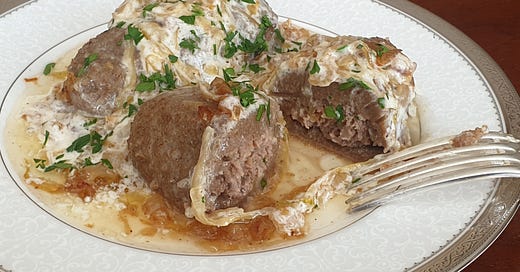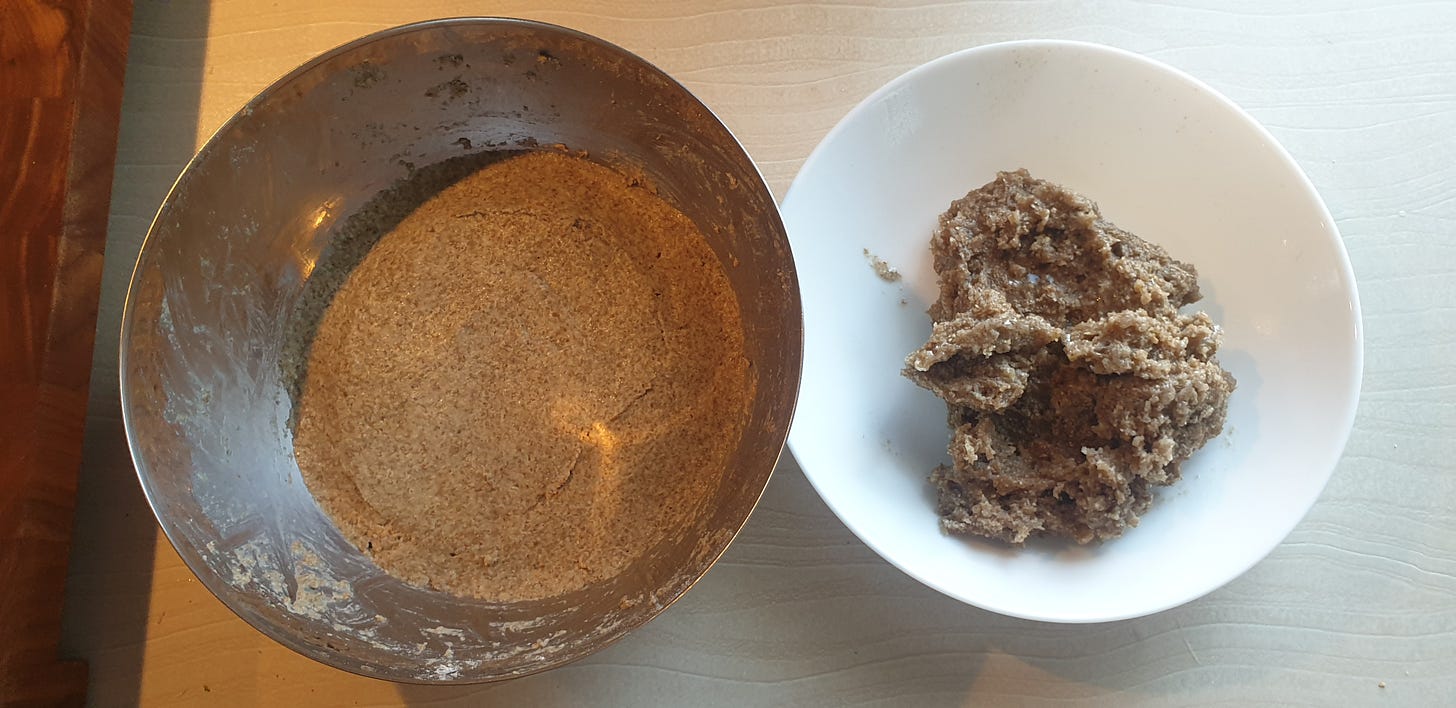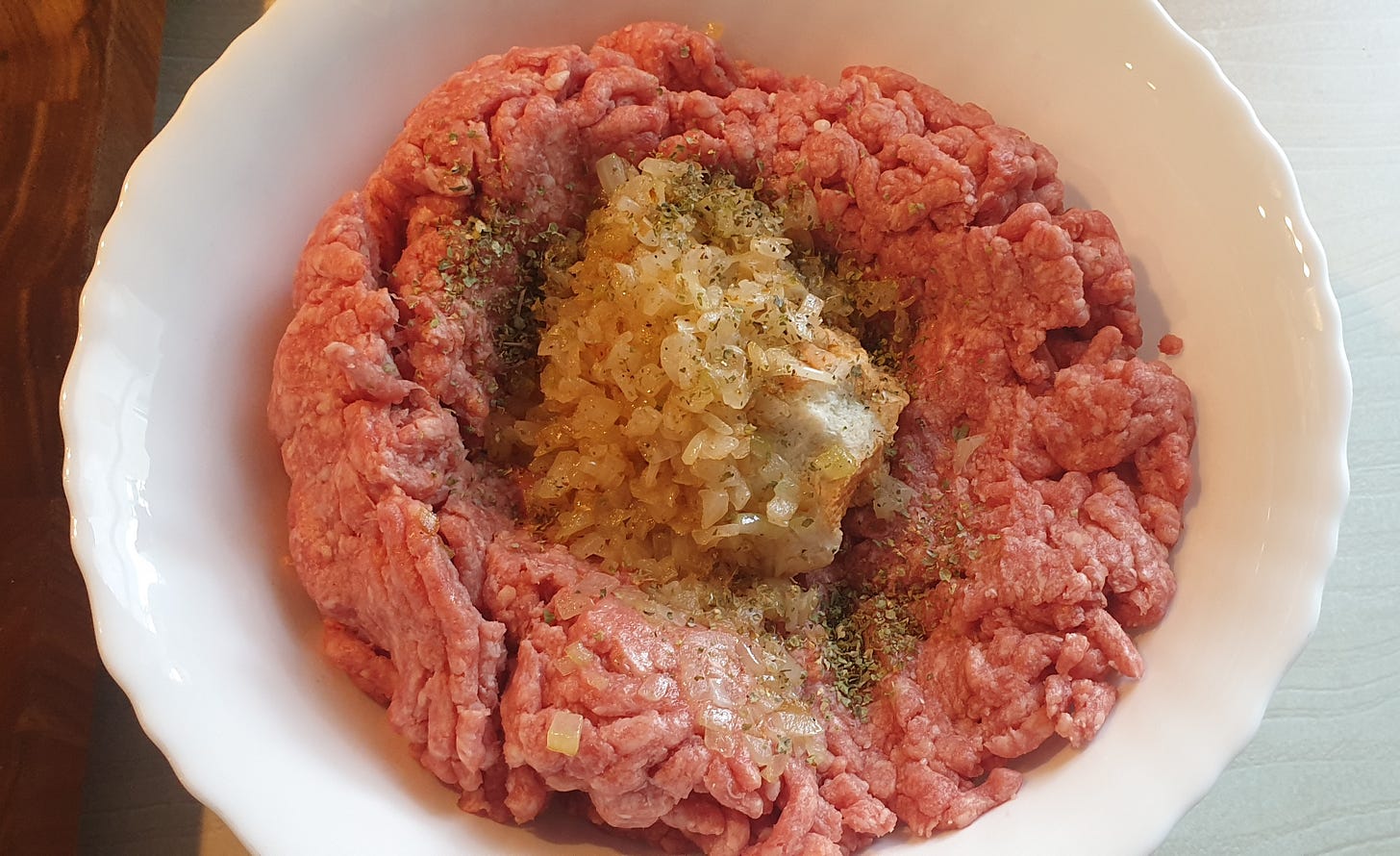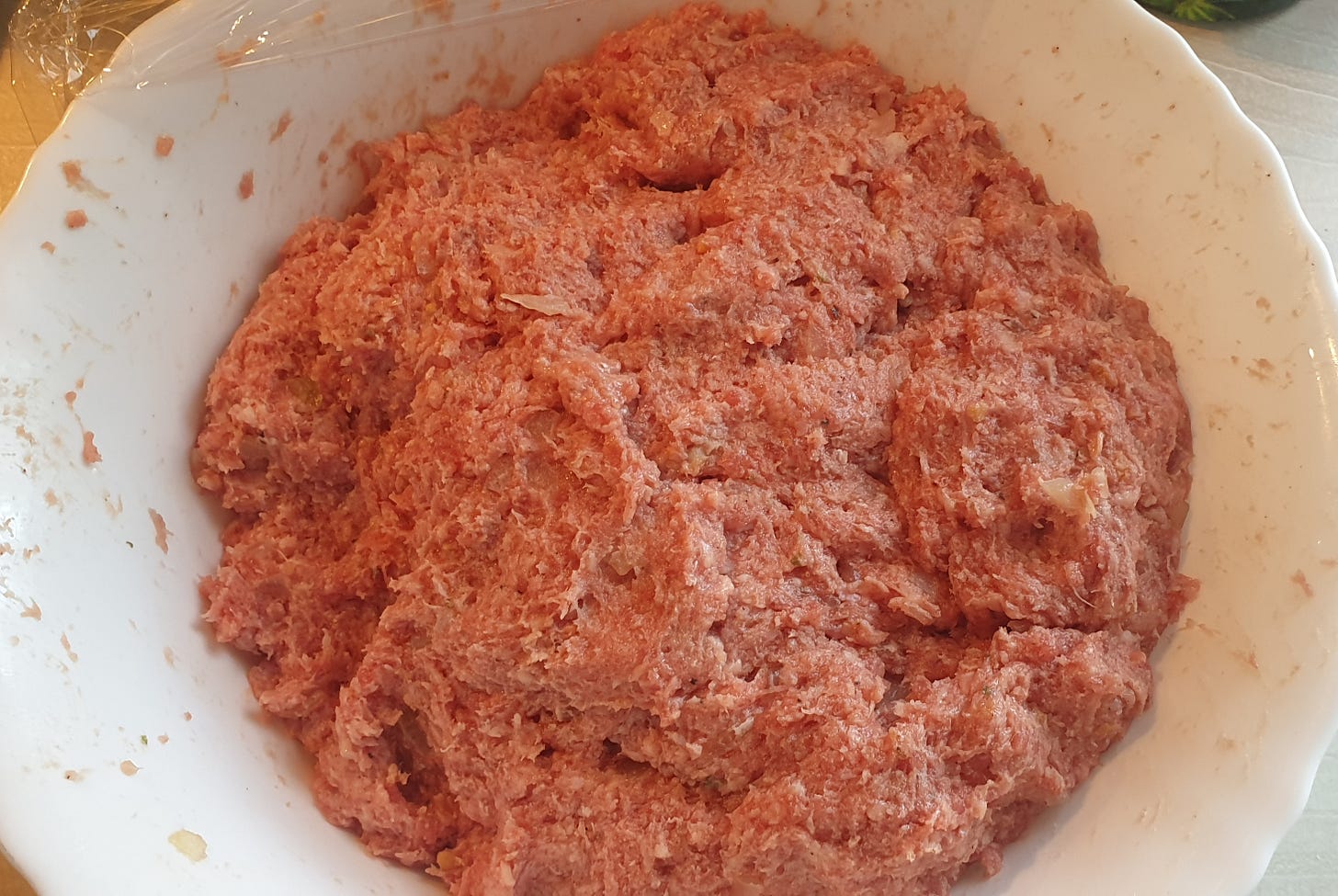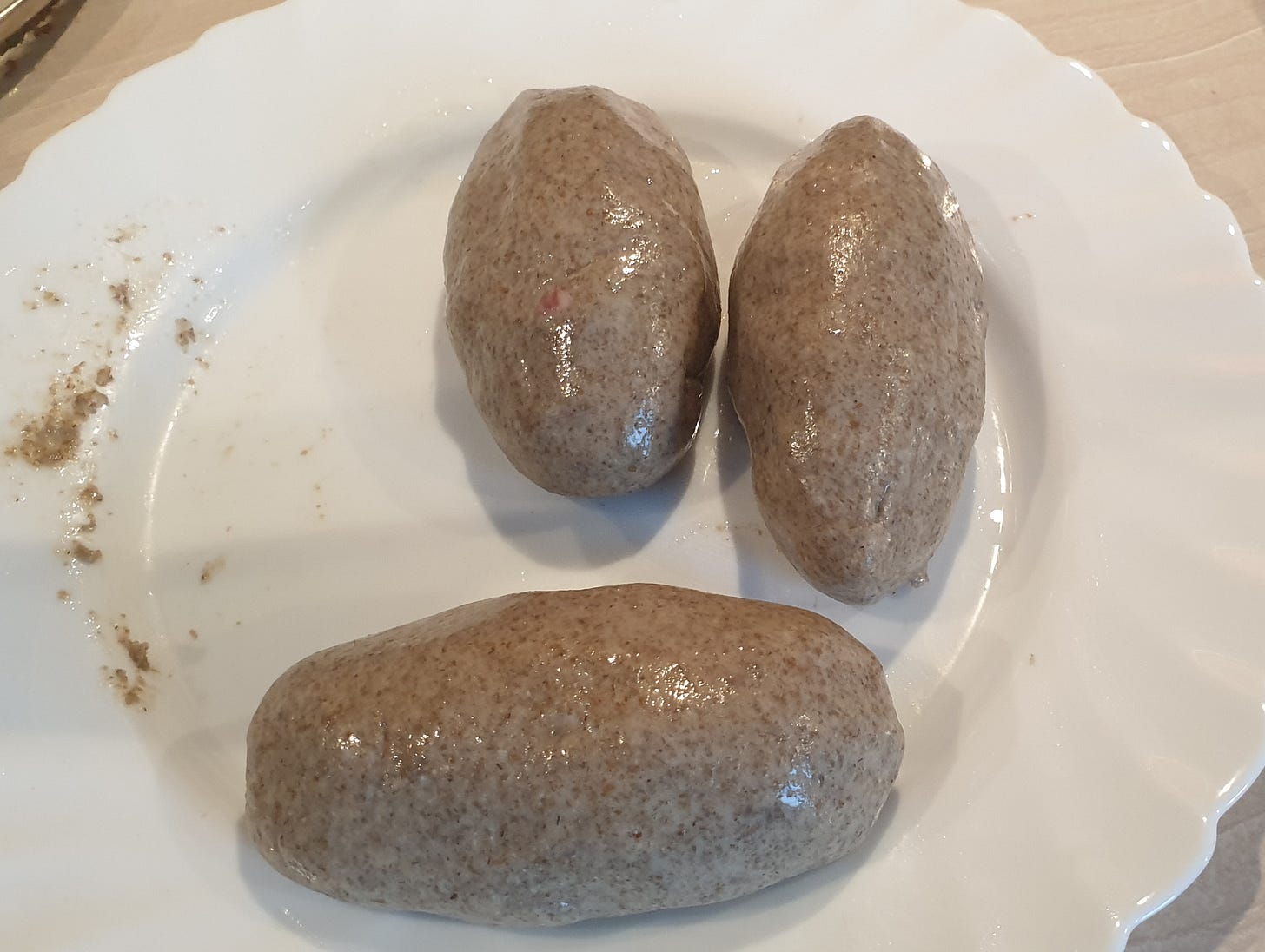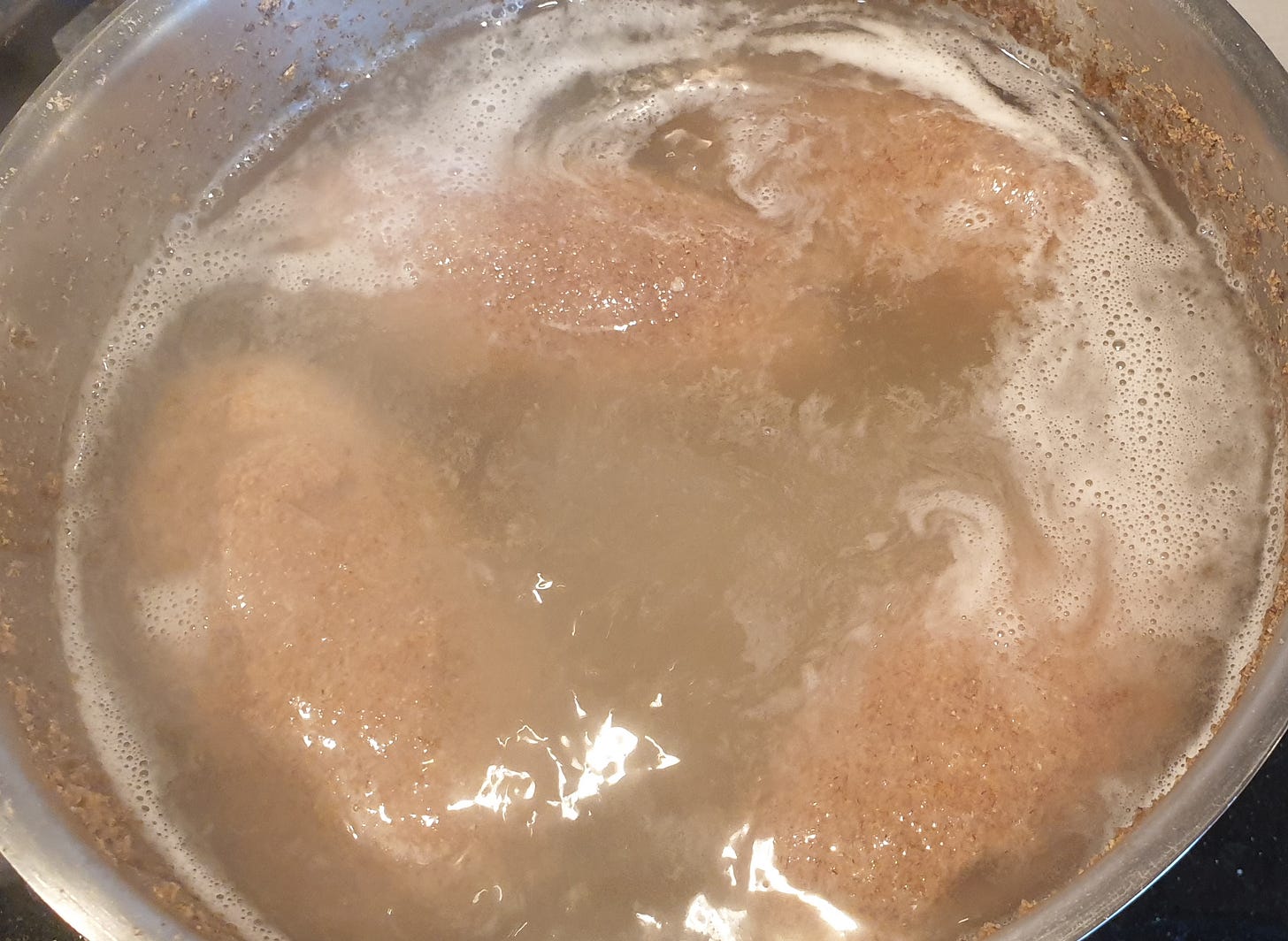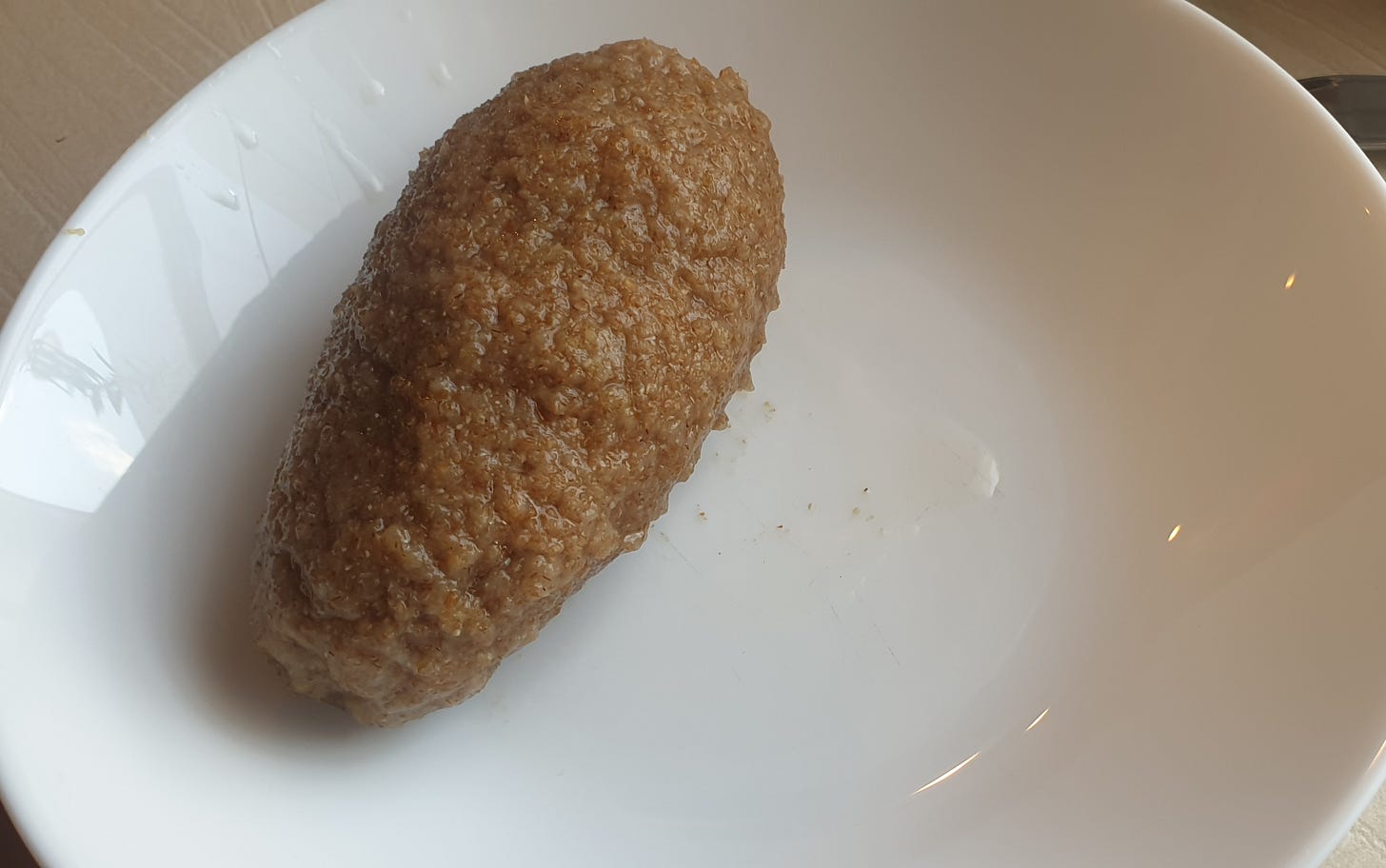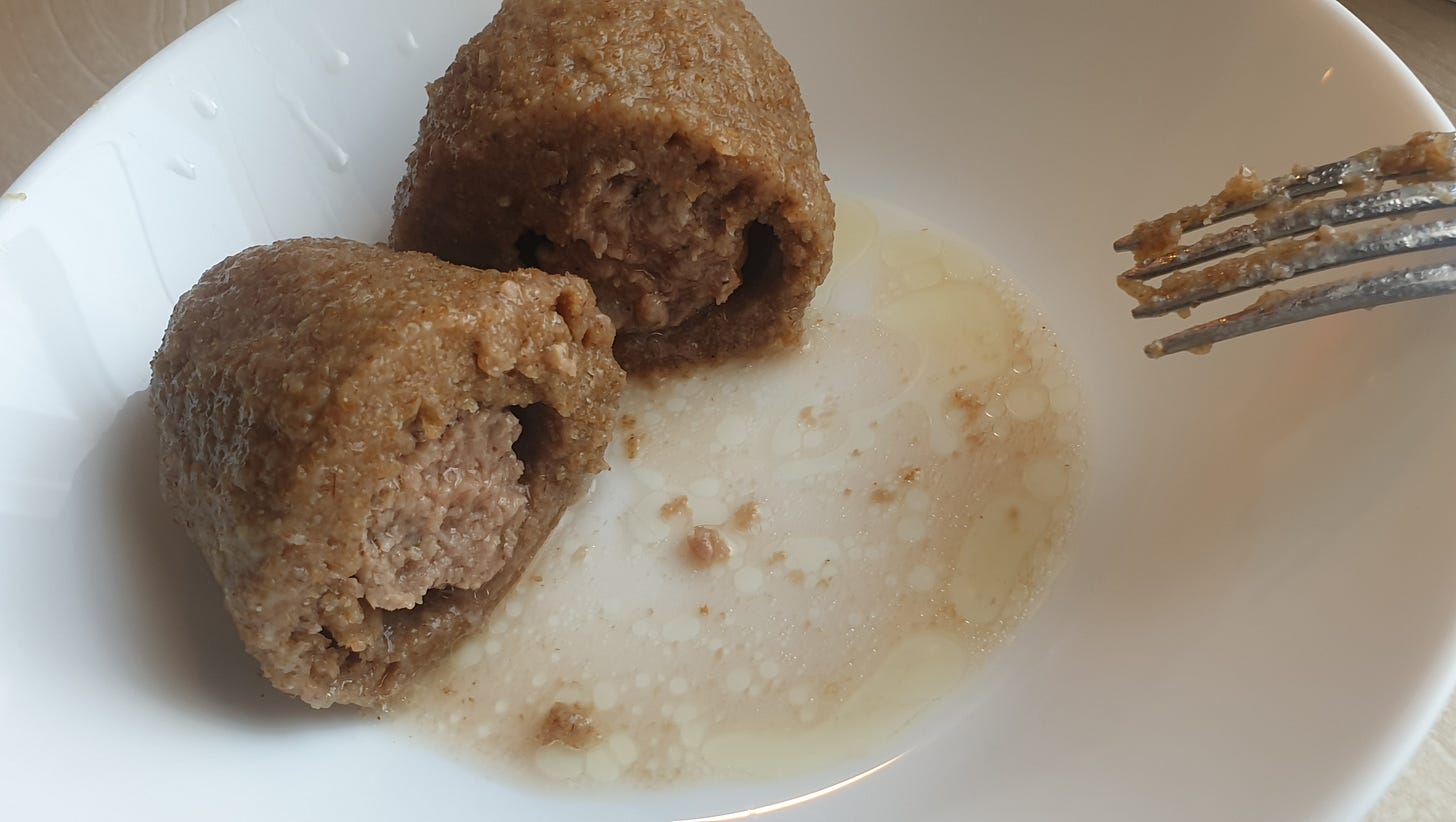What Is Proto-Indo-European for “Cepelinai”?
(No Potatoes Were Harmed In this Reconstruction of Historic Dumplings)
I’ve already talked once or twice about my observations on how changes in language, over time, can mirror the changes in a region’s eating habits. I don’t mean that shifts in language and shifts in diet somehow correlate – far from it. What I mean is that the patterns that shape how languages evolve – the ones linguists have already studied and successfully used not just to explain changes, but also to reverse-engineer lost languages and reconstruct hypothetical words used back when humans hadn’t yet invented writing – those same patterns seem to show up in food history, too.
Language Change as a Model
One of the best-known examples of this is the Proto-Indo-European language. We have no hard evidence that the words spoken around 4000 BCE actually sounded the way we’ve reconstructed them, but when we analyze the later languages that evolved from it, all the evidence points to a kind of “common denominator” that lets us hypothetically recreate those ancient words. Sure, it’s still a guess, but when direct information is so scarce, hypotheses and the process of disproving them are a powerful engine for developing theory. And so far, the theory of Proto-Indo-European has held up quite well.
There are many different forces that drive language change, some small, some sweeping. I’m not a specialist in this field, but I did notice something that linguists seem to treat as an axiom: it’s extremely rare for a change to affect just one or two isolated words. For instance, if the word for “bread,” which has been in use for centuries, suddenly shifts from duona to douna in a certain region, we can be pretty sure that this sound shift from uo to ou has affected many other similar words in the language as well. The reasons behind that shift are a separate question, but the change itself usually isn’t limited to just one word, but is widespread and impacts the whole language.
However, at the same time, this kind of patterned change only affects words that already exist – it rarely creates entirely new ones. In other words, the language mutates by slowly shifting over time.
And when we turn back to the world of cooking, I’ve noticed very similar patterns there too. Traditional dishes in our region tend to be quite conservative and stable for decades. If they’re tied to religious customs or basic survival, they can remain unchanged even for centuries. But when major shifts happen in society, its cuisine changes as well, and a whole group of dishes transforms at once.
Potatoes and the Great Shift
Around the beginning of the 19th century, potatoes began to spread in Lithuania, as well as in Poland and Germany. At first the adoption was slow and hesitant, but soon it accelerated. In culinary texts from around 1810, potatoes are barely mentioned at all. By 1910, though, they’d become an everyday staple, something people could hardly imagine living without.
I won’t analyze the reasons for how potatoes entered our life and why they spread. I’ll just mention one simple thing: in the span of about a century, a whole range of potato-based dishes suddenly appeared in our culinary repertoire, and they took root so deeply, it feels as if they had been eaten here since time immemorial. They appeared as if out of nowhere: potato sausages, kugelis, cepelinai, potato pancakes, švilpikai, mashed potatoes… Recalling those same principles of language change, one can’t help but be drawn to the theory that none of these dishes are truly new. In my opinion, they were already known in our culinary tradition, just made not from potatoes. Likewise, the appearance of the “potato shift” swept across many dishes at once, rather than affecting just one or two.
It’s easiest to compare those dishes for which we have both potato and other versions. Take mashed potatoes, for example. We still remember many porridges (although more and more are being forgotten, since they don’t have the same “hype” as designer pizza or sushi fusion – they’re seen as some kind of peasant relic that should be forgotten and gotten rid of as quickly as possible). Porridge can be cooked from peas, oats, barley groats, rye flour, and many other things. But if you take a look at the toppings for mashed potatoes, especially older recipes, from before the globalization and industrialization of cooking, you’ll see the same cracklings, or fried onions, or roasted hemp seeds as on other porridges.
Or take vėdarai, baked sausages made with raw grated potato. Blood sausages have also survived to this day, prepared in a similar way to potato version – stuffing flavored with cracklings is stuffed into casings and baked in the oven. In this case, potatoes replace barley or buckwheat groats, and the blood disappears, since potatoes don’t need a binding agent; their mass holds together well enough when baked on its own. Although maybe this isn’t the best example, because to me it seems blood sausages are simply one of the old forms of meat charcuterie, while potato sausages are more like a degraded modern invention made out of necessity, practically without any meat.
But there are dishes that, according to some culinary experts, simply cannot be made without potatoes – and that, supposedly, proves they aren’t truly “ours”. The argument goes that these dishes must have been brought in from elsewhere and handed to us fully formed. As if some benevolent Big Brother arrived with potatoes in one hand and a list of recipes in the other, generously teaching the poor, clueless Lithuanians how to cook. If not for him, the story goes, we might have starved to death. Depending on who’s telling it, this Big Brother might be Ashkenazi Jews traveling through Prussia, Prussian Germans themselves, Russians during the imperial occupation, or later, the soviet regime. What’s striking is how often these myths are repeated – even by Lithuanians.
The Case for Pre-Potato Dumplings
Take cepelinai, or large oblong potato dumplings, stuffed with meat, very popular in Lithuania nowadays. Their preparation method is very specific: part of the potatoes are boiled and mashed, part are grated raw, then the two are mixed in very precise proportions – otherwise the cepelinai will either be too tough to bite into or fall apart while cooking. As if in some kind of religious debate, this is presented as undeniable proof that someone gave the dish to us, that we couldn’t have come up with it ourselves, that it must have been imposed from above.
Meanwhile, my theory is a bit different. I believe that all those popular potato dishes made today – by us as well as by neighboring nations (Poles, Germans, Belarusians) – were already known before potatoes became widespread. For certain reasons, once the potato took over (and there could be many reasons for that, including early grain failure due to bad harvests, and the potato’s greater resistance to weather changes is not the least among them), existing dishes were adjusted and adapted so they could be made with potatoes instead. And if we carefully dig into history and try to reconstruct, using ordinary culinary logic, what those potato dishes might have looked like back when we still didn’t have potatoes, I believe we’ll find absolutely all of them already present in our historical cuisine.
With that idea in mind, I tried to recreate cepelinai as they might have looked, say, in the 17th century or earlier, when no one around here had even heard of potatoes.
First of all, we should immediately set aside the name cepelinai, since it’s linked to Count von Zeppelin’s airships, which only appeared in the skies over Lithuania in the early 20th century. But here’s an interesting thing: once I interviewed an elderly woman about her childhood, and she told me how her own grandmother had once told her about cepelinai from her childhood. We’re talking about the mid-19th century here, a time when the dish couldn’t possibly have had that name in Lithuania. No doubt the woman I spoke to had retroactively attached the name to the dish in her memory, but the important part is this – the dish itself already existed.
Most likely, it was called kukuliai, or kleckai, or something else. Kleckai probably came through Polish, or directly from the German Klöße (Polish word is kluski). But kukulis – that’s a purely Baltic word, and a very old one at that. I’m not entirely sure about didžkukulis, since it does sound a bit like a modern coinage, though I might be wrong and linguists could correct me. Later on in this text I may keep calling them cepelinai, but only because we’ve all gotten used to the name.
So, what could those large dumplings have been made from in 17th-century kitchens? Other vegetables, maybe turnips or rutabagas? No, those fall far short in starch content. To prepare them, you’d have to mix in quite a lot of wheat flour or the soft part of bread rolls, and plenty of eggs, just to keep the whole thing from falling apart during boiling. Besides, dumplings are a dish known to both the poor and the wealthy, so the technique for making them should have had something in common across all social classes.
One thing that immediately came to mind while thinking about this was rye bread dough. Even today, we still have those little rye dumplings boiled in water, made from the leftover dough in the kneading trough – when there isn’t enough for even a small loaf, let alone a proper one. That kind of dough works well enough for boiling small dumplings, but if you try to use it as a shell for a cepelinas, you’ll run into trouble: the dough is simply too dense. For small dumplings, or thin disks with a hole in the middle (which villagers in northern Lithuania call pindutės – a crude but affectionate regional term, refering to a certain part of female anatomy), that density isn’t much of an issue. But cepelinai made with a dough that firm would be a serious jaw workout, and probably never would’ve become a popular dish.
It’s very much the same with grated potatoes, by the way. If you grate raw potatoes finely, squeeze them until they’re just barely damp, collect the starch that settles from the liquid, and mix it back in, then try to make large dumplings from that mass – anyone who’s tried it will tell you: they’ll be inedible, rubbery. That’s exactly why cooked potatoes are mixed in. The starch in them has already absorbed water and swollen, so during boiling, it no longer pulls moisture from the dough to do so. That’s what makes all the difference in the final texture. Usually, depending on how starchy the potatoes are, the ratio of raw to cooked potatoes is about 2:1 – sometimes 3:1 if the potatoes are less starchy.
Rye Cepelinai Experiment
And after much thought, I decided to try making those cepelinai using only 17th-century techniques. Of course, it could just as well have been the 14th century, since everything I used was already available back then. Unfortunately, we don’t have concrete evidence of this, as Lithuanian written sources are very scarce – culinary books only begin around the mid-19th century. But we do know for certain that dumplings and similar preparations were already known in Europe even in medieval times, and among our closest neighbors, the Poles had also described them quite a long time ago.
The plan was this: mix part of the flour with water and knead it into a dough about as firm as squeezed raw grated potatoes; the other part would be scalded with boiling water or milk. The simplest way to do this is to use the pâte à choux method (that is, the technique for making scalded pastry), only with rye flour. Of course, you can also just pour the boiling water or milk directly into the flour and scald it that way, but the process is much harder to control like this, and that approach is better suited for when the main technique is already mastered and now just needs refining – to be done as quickly and efficiently as possible.
The Formula
For the “raw” dough, I mixed 100g whole-grain rye flour with 100ml cold water and let it rest covered for a bit to swell. For the “scalded” part, I brought 200ml of water with a pinch of salt to a boil in a small pot, then poured in 100g of the same flour, all at once. The flour instantly absorbed the water and swelled, and after a bit of stirring, the porridge-like mass turned into a dough that came away from the sides of the pot. I covered it and set it aside to cool. After weighing it, I found the final yield was slightly lower – about 250–260g – likely due in part to water evaporation, and in part to dough stuck to the pot walls.
So now we have the two doughs, and it’s time to find the right ratio. The cooked dough shouldn't be rubbery, but it needs to be firm enough to wrap around a piece of meat and hold together during boiling – in other words, to be turned into cepelinai.
I divided the raw dough into five parts and mixed in the scalded dough in these proportions: 0%, 10%, 20%, 30%, and 40%. I shaped them like pindutės for now, roughly matching the wall thickness of a real cepelinas, and boiled each one individually in water for 10 minutes.
By the way, the dough in every case was insanely sticky, and the only way to shape or form anything from it was with wet hands – constantly rewetting them as I worked.
Tasting Test Results:
0% – As expected, very firm. Since this is rye flour, not wheat, there's no gluten, so “rubbery” isn’t quite the right word. “Clay-like” is more accurate. If you’ve ever tried biting into a lump of clay or modeling wax, that’s the feeling. (And since I actually did bite some in kindergarten, I can say this with confidence 😊)
10% – Not dramatically different, but noticeably softer.
20% – Softer still, but still not suitable for cepelinai. Maybe for very small dumplings, if boiled a bit longer.
30% – The first result that would be acceptable for cepelinai, though for rather mediocre ones – where the dough is still a bit too firm. You often get cepelinai like this in cafeteria-style fast food places.
40% – When pulling the pindutė from the water with a fork, it split in half. In the mouth it quickly turned to mush, clearly showing that this percentage is already too high.
So the answer seems to fall somewhere between 30% and 40%, which rather neatly mirrors the raw-to-cooked balance in potato cepelinai dough. Incidentally, this technique isn’t unique to us. For example, the German Thüringer Klöße (Thuringian dumplings), although unfilled, are made with a dough nearly identical to that of our cepelinai.
So, the second test – actually forming cepelinai from rye flour.
I decided to try using 35%. The formula was as follows:
The scalded dough, same as before – 100g of flour with 200g of boiling water. I added a generous pinch of salt to the water, thinking it would distribute evenly throughout the dough once mixed.
The amount of raw dough was calculated so the full batch of scalded dough would be used. If 270g (this time's yield) makes up 35%, then 65% would be, rounded off, 500g – that is, dough made from 250g flour and 250g water.
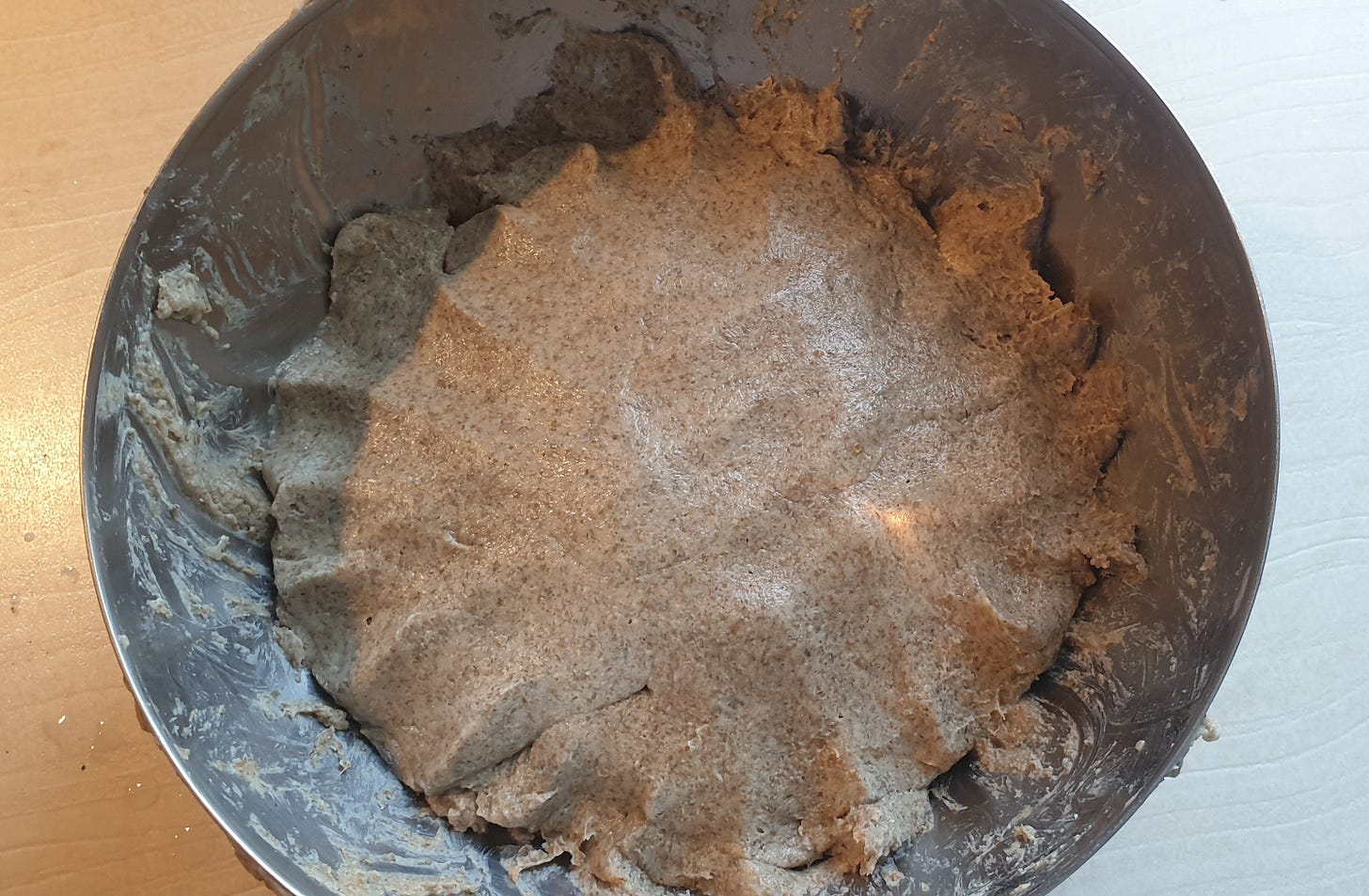
Let everything rest for a bit to swell while preparing the filling. I made more than needed, since I’d use the leftover for meatballs later. Into 1kg of ground meat I mixed in a sautéed onion, a fist-sized chunk of dried bread roll soaked in water and squeezed out, a tablespoon of salt, black pepper, marjoram, and a little clove and allspice. I stirred and kneaded everything thoroughly so it would bind well.
The method was exactly as I described earlier. Adding bread roll to the cepelinai filling might seem odd, but it makes the meat softer and juicier.
From that amount of dough, depending on the size of your hands, you'll get about 4 to 6 cepelinai. Since my palms are broad but short, I ended up with 5, plus a bit of leftover dough for small dumplings.
I gently lowered the cepelinai into boiling salted water and cooked them for 15 minutes. In other words, exactly the same process as when working with potato dough.
And here’s the result. I served the cepelinai with the usual cracklings, onions, and sour cream I normally prepare for the potato version – and they worked perfectly here, too. Admittedly, I made mine a bit fancier than usual, caramelizing the onions until nicely browned, but that doesn’t change the essence. The key point is that the technique is practically the same.

In other words, we can assume that when 19th-century housewives got their hands on potatoes – especially after a poor rye harvest – and once they figured out how to grate them, how to squeeze them (using a tool they already had: the cheesecloth bag), and how to collect and mix back in the starch, then with a bit of experimentation, they could simply apply the same technique they already knew from making scalded rye dough. And things took off from there. Of course, no one can say now for sure, what exactly the learning curve looked like or what early attempts were made.
But if I were suddenly transported back to the 14th century and told to cook cepelinai, I think I could manage. And they would say, “What do you mean cepelinai? These are just plain kukuliai with meat inside.” In other words, the dish itself was always known – no one brought it to us or gifted it. The only thing that changed with the arrival of potatoes was the use of a starchy dough made from a different base, but the technique remained exactly the same.
P.S. Were rye cepelinai tastier than potato ones? It’s a question of taste, obviously. To me they were just as tasty, albeit the rye shell has somewhat different bite. I think drying some rye bread, then grinding it into crumbs and mixing into the dough (replacing some of the scalded dough part) might actually bring it even closer.
P.P.S. Also I rolled the remaining dough into small 2 cm balls and boiled for 10 minutes, then poured some melted butter on them and ate with sourmilk, just the same way potato dough is used up nowadays. And to me, the rye version is actually tastier.
